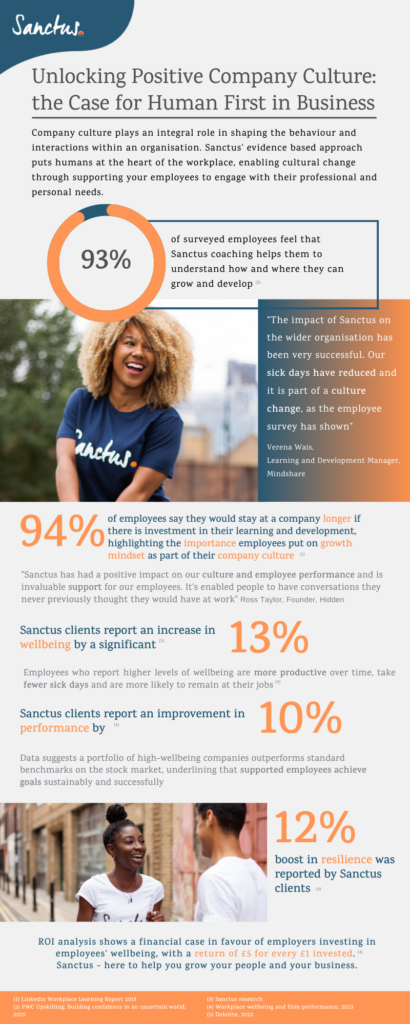Unlocking Positive Company Culture: the Case for Human First in Business
We’ve always thought we were on to something with our holistic approach – putting human beings first, and considering the many different moving parts of their lives in the coaching they receive.
Human First in Business is that approach fleshed out and nailed down. Our attempt at mapping the unmappable. Being able to say, once and for all, that this stuff works! That it has huge benefits for the employee experiencing the coaching, as well as the companies they work for.
So that businesses know what successful coaching looks like. So they can understand that the impact will likely be felt on the bottom line yes, but also in a million different ways. And so they’ll know exactly what they stand to get back when they invest in coaching.
Human First in Business is our attempt to investigate the impact of Sanctus Coaching on employees’ mental health and wellbeing, as well as the impact coaching has on workplace culture. It is best understood as the way we approach supporting employees through coaching: by putting the human first.
We have identified several key areas where coaching can have a positive impact in the workplace. From employee engagement, development, and growth, to wellbeing, performance, and resilience. Combining our own experience in the coaching room with decades of research, we have developed an approach to supporting employees that makes a real difference – to both their lives and business outcomes – regardless of the challenges or opportunities they may be facing.
We believe humans are the beating heart of any workplace. But we’re not the only one’s saying it. The data supports us too.
The benefits of coaching
The benefits of supporting employees with coaching are well documented.
Coaching at work is still a relatively novel thing: we’re only really going back to the 70s and 80s when it properly took off in the workplace. That said, we still have a good few decades of research we can pull on that charts how much of a difference coaching makes to people, and the businesses they work for.
In a nutshell: decades of studies show coaching makes a positive difference to the way people feel, relate to others, and work through everyday difficulties. As well as showing improvements in practical areas like performance at work and the ability to develop new skills and competencies.
The problem is none of this research definitively answers the most important question most businesses have.
“What’s the ROI of coaching?”
“What will I get back if I invest in coaching for my employees? What will it do to my bottom line? How will I know it’s been a success?”
And the truth is, those aren’t simple questions to answer. It feels like there should be a figure or a percentage you can point to. An X% increase in revenue, retention, engagement, or development.
It’s much more complicated than that. There are too many moving parts in coaching to narrow it down to any one thing. And anyone trying to simplify such a complicated equation is probably having you on.
To effectively answer these questions, we need to go back. We’ve been supporting people at work with 1-2-1 coaching since 2016. Our philosophy since then has always been to put humans beings first, and we have seen that this has made a huge difference to the people we work with. Feedback from employees we’ve coached over the years gives us a good indication of how effective the whole coaching experience has been for them.

Growth
This is important to understand how we “do” coaching at Sanctus. Our approach to leadership development for example, is less about teaching people a set way to be a better manager. But working with the individual to identify and lean into their strengths, and develop practical ways of overcoming their own unique challenges and barriers. To guide them towards becoming the best leader they can be, and the best source of support possible – for both themselves, and their team. To give them the tools they need to develop themselves.
By instilling a sense of ownership in an employee’s development, we often see people take real charge of their own growth, extracting lessons from experiences they might have missed previously, giving and receiving feedback a bit more tactfully. Little things like that that you can’t really measure, but make a big difference when they’re added up.
“The impact of Sanctus on the wider organisation has been very successful. Our sick days have reduced and it is part of a culture change” – Verena Wais, ex-Learning and Development Manager, Mindshare

Engagement
Employees generally put a lot of importance on a growth mindset as part of company culture. And there are “significant links between feelings of depression, anxiety, and job satisfaction on subsequent quit behavior”. (Green, 2010)
On the flip side, investing in employee learning and development seems to make people happier at work. Happy, satisfied employees are both more productive, and more likely to remain at their jobs.
“Sanctus has had a positive impact on our culture and employee performance and is invaluable support for our employees. It’s enabled people to have conversations they never previously thought they would have at work” – Ross Taylor, Founder, Hidden
This kind of feedback is of course very encouraging for us, but it isn’t 100% conclusive. It wasn’t until we started developing coaching tracks that the idea for a more structured assessment came to the fore.
Coaching tracks are Sanctus Coaching programmes designed to engage and develop specific cohorts, like: progressive leaders, women in business, new and returning parents. The programmes are a set number of sessions long and feature an assessment of the employee’s skillset at the beginning and end of their coaching.
As we began documenting the impacts of coaching on different groups, we realised that regardless of the situation employees were in, there were certain constants all humans could (and did) benefit from in the workplace.

Wellbeing
Sanctus Coaches support employee wellbeing by providing a safe space to talk through whatever’s on their mind. It might not be something they feel comfortable disclosing to their employer. Having access to this space is a vital resource for employees who may be experiencing challenges to their wellbeing at work, in life, or both.
Employees who report higher levels of wellbeing are more productive over time, take fewer sick days, and are more likely to remain at their jobs.
Wellbeing is most commonly used to describe a person’s physical or mental state of health. But it can also be used to refer to how employees feel about their job or work environment. From how well they are compensated to day to day working conditions, opportunities for growth and development on offer, relationships with co-workers, and so on.
There’s been a lot of research linking job satisfaction to performance, turnover, and wellbeing. One study in particular found that “job satisfaction was related to lower levels of anxiety and depression among employees.” Overall, there are hundreds of published papers identifying a positive correlation between wellbeing, job satisfaction, and performance.

Performance
Data suggests high-wellbeing companies outperform standard benchmarks on the stock market, showing that well supported employees are able to achieve goals sustainably and successfully.
The relationship between employee wellbeing and performance has been well examined over the years. Particularly among call centre workers, for some reason. Although it makes sense: it’s a tough job and performance levels are critical assessment criteria.
“Employees who were in better moods handled calls more efficiently – measured in terms of independently resolving issues without a supervisor and having more time available to customers – than less happy colleagues.”
The secret to unlocking elevated levels of performance in your employees? Make sure they’re happy.
Which sounds pretty radical, but it’s not exactly new. An analysis of manufacturing workers in the nineties found performance and productivity levels increased around 7% when people felt more satisfied in their jobs.
Sanctus Coaches support the performance of employees by tapping into their motivations and natural energy rhythms, working through more effective ways of handling tasks or overcoming problems, and digging deep to get through periods of challenge or high priority.

Resilience
Resilience is one of the most important soft skills the modern workplace requires, delivering a potentially massive ROI of 250%.
It’s the ability to bounce back from a set back, and not bend or break under pressure. Employees with a high level of resilience are able to work through difficult feedback, come back from a failed project with a new determination to learn, and view failures as an opportunity to learn and grow.
Studies investigating resilience found significant positive impacts of coaching, including but not limited to an employee’s levels of anxiety, stress, depression, and wellbeing.
When we coach managers on resilience, we tap into their innate adaptive capacities to work through uncertainty, respond effectively to the changing demands of a hybrid working world, and provide their teams with the clarity and direction they need. This models resilient behaviour really well to the employees they’re responsible for.
The bottom line
These are just a few of the most notable benefits we’ve seen coaching has. Naturally, there’s a lot more that goes into making sure people feel supported, happy, and empowered at work.

From how empowering the organisation is towards its employees, to how ready the individual is to deal with change. Whether the business cultivates a meaningful sense of belonging, to how effective the individual is at setting goals.
You might notice the benefits of coaching are interlinked as well. Engaged employees typically grow and develop more effectively than disengaged employees. Employees who perform well typically experience positive wellbeing and healthy levels of resilience as a result.
Coaching that puts humans first has a positive impact on company culture in two ways:
- Directly – by supporting individuals who would have a direct impact on company culture
- Indirectly – by making people feel valued and creating a sense of positive wellbeing in the workplace, where employees feel like they belong and can grow
So what will coaching do to your bottom line?
The short answer is that it differs from business to business.
The research makes a financial case for investing in employees’ wellbeing, with a return of £5 for every £1 invested. But the most meaningful impacts may be seen in other areas.
How employees deal with change. The way they communicate with colleagues. The effort they put into their work and how proud they feel because of it. Someone smiling for the first time in a while.
Essentially, people want to feel that they are just as important as productivity or profit.
We believe (and the research shows) if you put human beings first, profit follows. To continue reading on how we feel about company culture and talent, check out this page.

